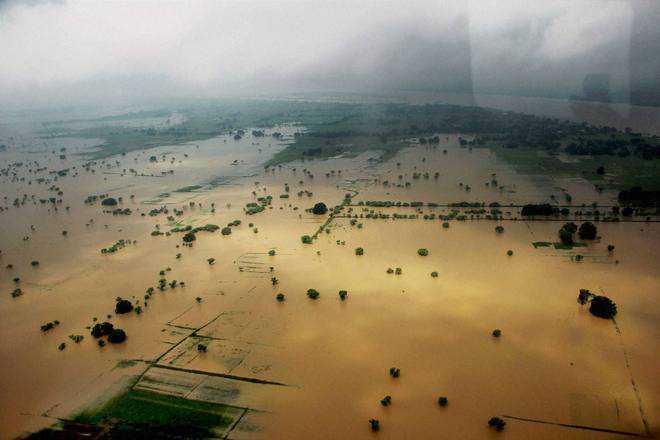
A flooded Shankargarh village in Allahabad. The inundation is being attributed to multiple factors, including release of water from dams. PTI
Vibha Sharma
Tribune News Service
New Delhi, August 23
As central and eastern parts of the country — Bihar, Uttar Pradesh, Madhya Pradesh and Rajasthan — reel under floods, experts are pointing to reasons other than heavy monsoon rain for the catastrophe like heavy silting of the Ganga, haphazard infrastructure development and mismanagement of dams, in this case Farakka.
Hundreds of thousands of people have been affected across the flood-ravaged states with swathes of agricultural land with standing crops submerged. Besides state agencies, the Centre has pressed NDRF companies for rescue and relief operations. While agricultural losses are not yet been assessed, officials admit huge losses to both man and property in these floods.
Heavy silting of Ganga as one of the causes was also pointed out by Bihar Chief Minister Nitish Kumar when he met Prime Minister Narendra Modi today. Seeking the Centre’s intervention, Kumar said de-silting Ganga was the only solution to avoid the almost annual occurrence. Unless riverbeds are de-silted, the problem will keep recurring, he said.
The Prime Minister promised immediate action, including formulating a national silt management policy, Kumar said after meeting the Prime Minister.
As per environmental expert Himanshu Thakkar, Kumar’s demands are legitimate. “He raised it earlier also but it seemed the Centre was not listening,” he says.
Though flooding in MP and Rajasthan can be attributed to excessive rain, Bihar received 14 per cent less rainfall than normal during the season. Several parts of Bihar and neighbouring Uttar Pradesh came under floods due to heavy rain in Nepal and Madhya Pradesh and Jharkhand, resulting in huge discharge of water into rivers passing through these states.
IMD officials attribute heavy rains in central regions to three back-to-back systems over a long period. As per IMD Director BP Yadav, Madhya Pradesh and regions adjoining it received heavy rain for “a bit longer than usual” this season.
“They are not record breaking rains, but 15 to 20 cms of rainfall everyday continuously for over 15 days is bound to create problems,” he says. “There has been no respite and Madhya Pradesh in particular received more than 40 per cent more than usual rain and likewise Rajasthan,” he adds.
Their intensity may reduce but the rains are not expected to stop, at least over the next couple of days, he says.
More than the monsoon, Thakkar says, the cause of these floods is mismanagement, mostly of dams, and of course the haphazard development and embankment of the river.
“Himalayan regions, like Uttarakhand, are vulnerable to flash floods and all development should be undertaken keeping that factor in mind. However, the rains received this year are not unprecedented. They have occurred in the past as well,” he asserts.
He says “mismanagement at Bansagar Dam and the drainage congestion and siltation in Ganga created by the Farakka dam together created an avoidable flood disaster this year in Bihar and now in Uttar Pradesh”.
Thakkar says reservoirs like these should only be filled closer to the end of the monsoon and need to be operated in such a way during the monsoon that when downstream area is getting high rainfall, or facing floods, the reservoir does not have to release water to add to the downstream flooding.
“Unprecedented floods in the Ganga in Bihar and UP are largely due to contribution of Bansagar Dam on the Sone river in Madhya Pradesh in the upstream and Farakka Dam (misleadingly called a Barrage) on the Ganga in West Bengal.
“Had the Bansagar dam been operated optimally, it need not have released over 10 lakh cusecs of water. As pointed out by the Bihar government, the heavy flooding brought about by the Ganga in Patna is majorly due to the high flow contributed by the Sone upstream of Patna”.



























